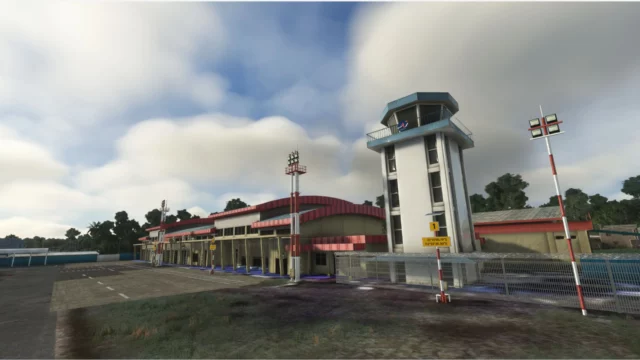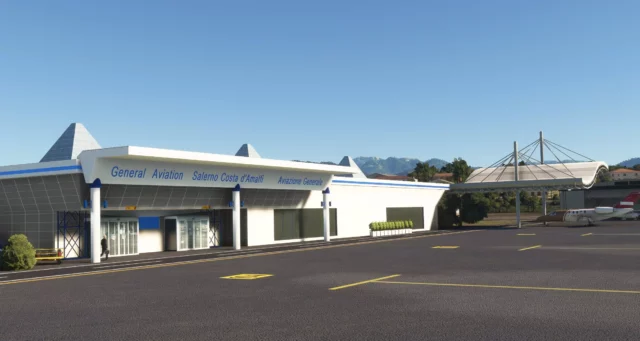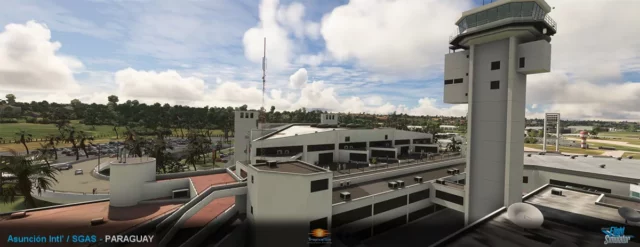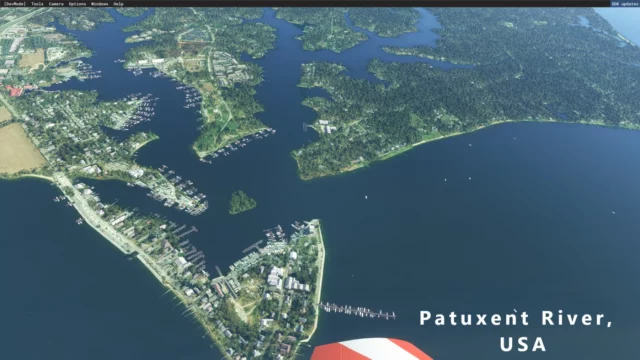 Dudley Henriques has long been our ‘resident test pilot’, working for Microsoft to help them make their aircraft models more realistic, and helping the flightsim communities learn how things are done ‘in the real world’, specializing on the classic jet fighters of the now previous age. Man, does that make us feel old! But old is good in this instance, because it means experience.
Dudley Henriques has long been our ‘resident test pilot’, working for Microsoft to help them make their aircraft models more realistic, and helping the flightsim communities learn how things are done ‘in the real world’, specializing on the classic jet fighters of the now previous age. Man, does that make us feel old! But old is good in this instance, because it means experience.
Dudley had tremendous problems in the past with getting FSX to run, and he even quit FS for some time because of it, but he’s back and has things working now. So we’re happy to see he is getting enthusiastic again and wants to share his wisdom with us. Read his story below !!
An editorial by
Dudley Henriques
President Emeritus
International Fighter Pilots Fellowship
MVP 2006-2007 Microsoft Flight Simulator
I don’t have to tell any of you that FSX, since its release by Microsoft, has been a source of much conversation and speculation in the flight simulation community. We’ve all heard the pros and cons. I think I can speak for a lot of us when I say that generally speaking, each one of us has come to view FSX in our own individual way. It’s been an interesting ride for sure, filled with drama, back and forth, and if we look hard enough within our community, we can even find the love and hate for the “plot” found in any great novel.
With this article, I’d like to address my own personal experience with FSX, and profile for you where I see the program going as we project it and travel with it into the future.
Let me start out by saying that I began my own FSX experience at the start of the Beta process as an advisor with the Microsoft Beta team on aircraft realism. I watched the program progress through its various stages all the way on through it’s release. It was indeed an experience that taught me a lot more about the computers I was using along the way than I ever knew before. 🙂
There were (and they still are believe me) some extremely talented people working on the FSX program. Hal Bryan and the crew were breaking new ground with programming a flight simulator and trust me, from just listening to and watching the ACES team deal with it day by day, and seeing first hand what was going on, I can tell you it was no easy job! The ACES team wanted to put out the most advanced flight simulator yet developed and doing that required several other factors falling into place to make that happen; namely the new Direct X, Vista, and even drivers coming on line for a whole new projected technology of video cards. Add to this the sudden change by the computer industry into multi-core processor technology right in the middle of all this. I mean it was a confusing time for everybody and a paradigm shift in industry thinking.
Factor in all this having to come together at one time to a smooth coordinated conclusion for the FSX release while the team at ACES had to struggle each day with the ups and downs affecting each factor as they coded their new flagship flight simulator and you just might come away with some conception of just how difficult the job was for the ACES team.
So was FSX a success after all? IS FSX a success, and where can the community go with FSX from this point in time onward. Has the decision by Microsoft to end the franchise been a negative for the community?
Well I for one am here to tell you that in my opinion, the answer to these questions can be summed up in one positive message; that message being that FSX is very much alive and well. I mentioned before that ACES represented a VERY smart and savvy group of professional people. Fortunately for the community, their foresightedness in coding FSX for the future resulted in a legacy for FSX that allows those who are coming after ACES to build on the foundation they formed with their talent, their ingenuity, and their creative thinking.
YES, thanks to what ACES left behind, FSX is not only alive and well, it’s better than alive and well. FSX provides a base structure of code that is just now coming of age as creative add on designers and developers are as we speak producing new and exciting programs for FSX that are breathtaking in both beauty and performance.
My role in the simulation community has always been of a dual nature. I use the simulator for my own personal enjoyment while at the same time I work with the best add-on developers in the business as a consultant on aircraft realism, accuracy, and fidelity. I take on selected designers I know and respect and help them create for you the end user, a realistic add on product based on my personal experience having flown the aircraft involved. Its been a rewarding and educational experience for me as well as the designers I have worked with. I take this work I do quite seriously as many of you know, and I don’t commit to print what I don’t believe is in the best interest of the community at large.
Such is the case with FSX.
Considering what I have said thus far, I’m sure you can appreciate that realism and immersion are at the top of my priority list for any product I’m involved with, and that these factors are the main area of my interest when working with a developer.
As a retired Flight Instructor still deeply interested in and involved with the teaching and safety end of American aviation I have long envisioned MSFS as a source of tremendous potential as a training aid to real world aviation. Considering this, I have contemplated seriously the pros and cons involved with MSFS used in such an environment.
I’ve watched and helped the program develop through it’s various stages, but it wasn’t until I saw what some of the developers out here are doing now with FSX that I could actually see some of this potential played out in the simulator.
I’m not here to sell FSX to you as a training tool. My purpose here is to relay to you that what I’m seeing now being done within FSX by developers who have upgraded the program into what I believe is a simulator worthy of serious positive comment as the program affects YOU, the end user.
Remember I mentioned several factors I believe will define the future for desk top flight simulation? These factors are an actual trend toward realism, accuracy, and fidelity. I equate all these factors to a single all important design model. That design model can be summed up in a single concept, and that concept is a designed in UNPREDICTABILITY within the flight experience!
You can build a “game” around predictability, where the outcome of a performed action or the outcome of an unperformed action has been preordained by the code placed there for you by a programmer, but for anything approaching the realism, accuracy, and fidelity found in the actual flight experience, you MUST have a factor of predictable outcome ONLY if correct procedure and/or action is followed. For ANY flight simulator to even approach the real world flying experience the designer of that simulator has to eliminate the predictable outcome factor and find a way to make predictability of outcome based on the performance of the aircraft, and that performance directly linked to the performance and action or even inaction of the sim pilot flying that aircraft.
In other words, programmed failures from a failures menu don’t cut the mustard in the real world of aviation. That’s fine for the ”game” format, but not for a true simulator. KNOWING a system or a function will go down at a pre-selected time HAS to be improved and upgraded to a pilot performance and/or environmental situation trigger for the true flying experience to be duplicated toward any semblance of realism.
Any sim pilot can get into a pre-programmed cockpit in a simulator, fire up the engine, take off and fly the airplane. Even with what up until now has been a predictable failure mode for your flight if you desired to program those settings in, you still have that failure happening at a selected time.
You guessed it; no unpredictability! You fly KNOWING beforehand that you will either be encountering an in flight problem or you won’t be depending on what you pre-selected in settings for that flight. This might be interesting, but it’s not real word aviation.
In the real world you have to monitor engine and aircraft performance CONSTANTLY by careful operation of the aircraft’s systems, and a careful watch of the engine instruments. If you don’t do this and do it properly, there is a penalty to pay in the way of an in-flight problem that can range from a simple issue to a catastrophic failure. In the real world, you have to fly the aircraft CORRECTLY and monitor your instruments CONSTANTLY and act and even preempt with the aircraft in real time to what these inputs are telling you needs to be done. Fly an airplane and don’t do this and you might not make your destination! It’s that simple. Games are games, a GOOD flight simulator recreates the REAL flight experience.
Now naturally a desktop flight simulator can’t take the place of a full motion simulator, as to duplicate the FULL flight experience, actual control pressures must be duplicated. These pressures of course differ from aircraft to aircraft, and in the case of most light aircraft anyway, differ as dynamic pressure changes on the control surfaces at various airspeeds.
A desktop flight simulator CAN be made more realistic if designers can work with code that is capable of putting the sim pilot and not the simulator in charge of the flight………..and that ladies and gentlemen, is EXACTLY what ACES left for us in FSX in the way of code for add on designers to work with to produce the experience I’ve been discussing here with you.
Now let’s take a look at a sample not only of what FSX can produce, but what FSX has in actuality already produced for the community as we view a sample program from the capable hands and creative minds of a superb add-on design and development team.
Enter the world of ACCU-SIM!
Find data on A2A Simulations Accu-sim at this link
http://www.a2asimulations.com/accusim_p47_razorback.html
Keep in mind that Accu-sim can be adapted for use with a variety of airplanes available for use in FSX. It’s shown here as installed for use in A2A Simulation’s absolutely beautiful Wings of Power 3 P47 Razorback Thunderbolt.
FSX code has made available to developers and designers with the genius of Scott Gentile and his team at A2A Simulations as well as others, the ability to create this level of realism and immersion, and by doing so, for the first time in the history of MSFS, you can be REQUIRED to fly an aircraft in the simulator exactly as you would have to fly it in real life…………or suffer the consequences!!!.
With FSX, not only is the world prettier than ever before, but with the addition of the 2Service Packs, frame rates have become much more computer friendly. The base simulator is simply better than its predecessor by leaps and bounds in all categories, butthe category where it excels the most is in its ability to allow programs like the A2AAccu-sim Extension Package to be applied to an aircraft.
Trust me on this one. You install FSX and fly an aircraft in the simulator using Accu-sim and you will NEVER be satisfied flying anything without Accu-sim ever again!
(No folks; I am NOT being paid by A2A to tell you this :-))
For the first time with a desktop flight simulator, as an option available to you if you choose to use it, you can bring up an aircraft to fly, and literally be FORCED to fly it correctly OR ELSE! With Accu-sim there’s no more setting up the Auto Pilot and running upstairs to make coffee for yourself. You do that and your aircraft just might go off mixture, lose Manifold Pressure, suffer a supercharger surge, lose oil pressure, gain or lose oil temperature, or change cylinder head temperature on you because your cowl flaps are positioned incorrectly. There’s now a whole world of hurt for your flight if you are goofing off with your airplane. Thanks to Accu-sim, you can now THINK and ACT like a pilot instead of a “gamer” 🙂 What I’m telling you here folks is simply that for the first time, thanks to the Basic FSX code being what it is as given to the community by the ACES team , you have the option now to take FSX seriously and fly using it as a real pilot would do.
In other words, thanks to ACES, and designers like A2A and other talented developers out here, you now have at your disposal………….A FLIGHTSIMULATOR!!!!!!!!!!!!!!!!!!!!!!!!!!!!!!!!!
I hope this article has succeeded in straightening out a few of the misconceptions that have surrounded FSX and at the same time acquainted you with just some of the possibilities the future of flight simulation has in store for you.
Dudley Henriques
Apart from the information on A2A’s website, you can find all their products here at simMarket too.


![[Video🎬] New Trailer 4K for Turkish Airports MSFS by SceneryTR Design – Istanbul – Ankara Trabzon by SIMMARKET](https://www.simflight.com/wp-content/uploads/2024/04/SceneryTR_thumb.jpg)





0 Responses
I agree, FSX with the right add-ons is a thing of beauty. It’s a shame that in light of FSX’s capabilities the future of the franchise is unclear. I imagine developers would already be looking for alternates to FSX that provide a clearer roadmap for the future, regardless of how expandable it is and how many years remain under its hood.
Developers are indeed.. some even seem to be taking it upon themselves to build a new one. Unfortunately there is nothing in sight currently that is even remotely clear……
No matter how good MSFSX is, it will always remain as a video game. Know why? Because MS has willingly disallowed it to be used for commercial purposes which prevented developers from building a FAA-approved version based on the original software.
Why is FAA approval for a simulator important? Because if a simulator isn’t FAA-approved, it simply means you’ll be wasting your time running it thinking you’re simulating the real stuff although you’re not. When a simulator is sent to FAA for approval, FAA officials check it for frame-rate, whether or not it has accurate flight dynamics etc.
Without FAA approval, you have no way of knowing how accurate the flight characteristics of the aircraft you’re flying in the simulator. What’s more worse is that not knowing how accurate your aircraft is will immensely hurt your flight training in real life as well. So, all the money and time you spend on MSFSX or a simulator that doesn’t have FAA approval will simply be wasted and never help you learn to fly a real aircraft in real life.
Now you can say, “But the developers of my favorite aircraft, for example FlightOne, AOA etc said they hired 747 captains, instructors etc to build it”.
My response to that is: The developers will always say that to increase sales and market the product to people like you who have zero knowledge on aviation as a whole. They already know that whoever would buy MSFSX thinking it would help him learn to fly a real 747 (or a cessna 150 even) is a moron who doesn’t even know the very basics of flying, flight training, how to get a certificate, and the mandatory requirements etc.
X-plane is FAA approved, and no I don’t work for them and as a matter of fact I hate it a lot since it doesn’t have the gazillions of bling-bling that MSFSX has right out of the box.
But…in real life, you don’t jump out of the cockpit while in flight and take a screenshot of your aircraft. In real life, what’s most important is the flight characteristics. And X-plane shines in that area, which is of utmost important.
However, X-plane developers are making huge improvements recently. X-plane 9.30 is about to go public in a matter of days. Don’t forget to check it out
oops I just realized I can’t edit the comments. So here are two corrections: Please replace the word ‘Moron’ with something decent. I shouldn’t have used a slang. But I was typing real fast and it’s 8:16 AM in the morning and I’m feeling kinda groggy. So I’m apologizing for it 🙁 Please accept my apology.
secondly, please replace the word ‘important’ at the last sentence of the 7th paragraph with ‘importance’.
Thanks
Thank you for calling me – and every other real world pilot who uses any other sim than X-Plane for fun, or to practice procedures – an idiot, clueless and a moron in one post. Now go away and do some research elsewhere than X-Plane’s marketing hype before you even consider posting in public again.
Your “facts” are incorrect, misleading and potentially downright dangerous.
In order to use a simulator – ANY simulator – as a training tool, the whole package – controls, environment, software fidelity and procedures – has to be certified. X-Plane without this full system certification is nothing more than an entertainment sim, the same as FSX. Buying X-Plane (or FSX, or Elite, or any other sim), installing it on your home PC, then logging the hours towards flight training or experience is highly illegal and to insinuate otherwise is absolutely stupid.
The FAA, JAA or any other licensing agency could not give a monkeys about “frame rate”. You might like to check out some real licensed packages, such as Elite, and compare the frame rate on those when they were licensed to what you get in any modern sim running on any modern computer. They were far lower.
What they do care about is fidelity in flight and there, again, X-Plane (or FSX, or Fly!II, or Flight Unlimited) is allowed to be used as an aid to, not a replacement for training or building flight hours. It is used by a lot of people working on homebuilts and experimental aircraft to test ideas, but that’s because developing for any other sim (not just FSX) is a nightmare – X-Plane’s modding system is excellent and makes creating and altering a flyable model very easy indeed. However, you cannot certify an aircraft as airworthy using X-Plane – only truly certified software or real world flights can be used towards that.
When developers of any entertainment software involve real world pilots, engineers and operators of the type being modelled in the design process, they are trying to make the simulator as real as possible within the realms of the entertainment title that it is. Even the much lauded 747 Precision Simulator 1 desktop package was never licensed as a training tool, it could only ever be used as an aid.
As I said before, you really need to do more research, away from Austin Meyer’s sales pitch, before posting such utter rubbish in public again.
By the way, one topic you really might like to research is “ESP”. Look it up.
*Sigh* Another one of the majority X-plane fanatics I presume ?
This is SO like the gazillion useless Windows vs OS/2 debates we saw back in history, or VHS versus Betamax, or BMW vs Harley….
To each his own, these are polarized issues.
In one thing you are not correct though, and that is claiming that spending time on MS simulators for real pilots is wasted. It is not. It DOES depend on HOW you use it, but be assured there are many ways in which it helps pilots learn, train, stay current and educate, every day.
Francois is correct. It’s not the sim that makes the training equation, it’s the instructor. A good instructor using a stick man and pencil and paper will turn out a better student than a poor instructor using either FSX or X Plane every time.
Both FSX and X Plane have their uses in training and those uses are limited. Right now both sims are better used as procedures and systems visual aids.
It is notable that the marketing models for each sim are by necessity quite different, Microsoft’s by virtue of their huge expense in resources being aimed at a much more vast a market.
As for the FAA; after close involvement with the FAA working both with them and against them for over 50 years, I can tell you that anyone who places all their marbles on the FAA as being the end all for QUALITY when it comes down to a training device should also be considering the fact that every aircraft certified for safe flight and virtually every pilot certified as being safe for flight in the United States passed through the portals of the FAA.
This isn’t to say the FAA is fatally flawed on safety issues, but it certainly IS to say that in the end analysis, it isn’t FAA certification that makes a training aid a GOOD training aid, but the quality of the training aid itself coupled with the input of the instructor using that training aid.
The issue of desktop simulators as a training aid is an entire subject unto itself and as I have said in the article, deserves it’s own extensive discussion.
The article as written simply addresses the issue of FSX as it exists now and as it can be projected into the future.
X Plane has it’s own following and is a worthy program. I see no need for the advocates of either side to attack one another in any way.
As a CFI, and a damn good one at that, I would be perfectly content to use either MSFS or X Plane with a student and be more than capable of utilizing the pros of each program while at the same time avoiding the cons.’
The sim is just a tool. In the end, it won’t matter who is certified or not certified by the FAA. What will matter in the training scenrio is how the simulator is used by those using it.
The bottom line on “official logging of time” as that relates to training is all that’s important to the FAA certification. To ANY good instructor, this is simply one factor, and not all that important a factor at that, in the flight training scenario involving desktop flight simulators.
Dudley Henriques
What is being said about FS not being used as more than a game is simply untrue. I’m working with several development companies that indeed are using FSX far beyond the scope of a “game.” One of the teams I am working with for example is demonstrating the capabilities of FSX directly to generals in the USAF in an effort to change some of the ways that training is conducted, using FSX as a procedural and ambient sim (ATC anyone?). This is but one of many examples I could give, and the whole premis of ESP was to bring the commercial market in line with FS.
There are a lot of ways to make the stock aerodynamics non-existant and implement different parameters too. That is the beauty of FS, that we are only tapping now into the potential of what can be done with the right people and a little money put in the right place. Disagree with me? Let’s see how the FS market pans out in the next 5 years, and I’ll be laughing all the way to the bank.
X-Plane is great, but they are not the only game in town for SERIOUS work, FAA included.
Its not a game. I use it to relief the daily pressures in teaching as therapy and I use it for teaching Visual Art in Grades 3-5. Yeah who ever thought of that, I did on my own. Works well for keeping kids interested in and focused on learning and making those connections across all subjects through art.
I agree that we are only now seeing the greater potential that FSX can offer. I also agree that A2A has done a great job with exploiting some of this potential. But other developers are also providing other pieces of the puzzle – Aerosoft with the complex systems & engine management of the Catalina, Flight1 with visible icing effects on the airframe of the Cessa Mustang, FSD International with their persistant damage modelling, etc. Unfortunately there is no product yet that pulls all these things together. And though A2A looks to be now doing a GA plane now nothing currently on offer is anything but warbirds, which is not my cup of tea.
Open source code is the key to ANY future of ANY sim. Microsoft refuses to open their source code for FSX or ANY other product they produce, thus retainning control of it long after they stop supporting it. FSX does have a lot of potential, but its potential is limited due to the need for higher speed hardware, and its “closed” source code. It is my hope that a group of programmers can build a sim with open code that will offer infinate growth possiblities well into the future.